- Kenmore refrigerator water filters
- Whirlpool refrigerator water filters
- Samsung refrigerator water filters
- GE refrigerator water filters
- LG refrigerator water filters
- Frigidaire refrigerator water filters
- KitchenAid refrigerator water filters
- Maytag refrigerator water filters
- Kenmore Elite refrigerator water filters
- Estate refrigerator water filters
- GE Profile refrigerator water filters
- Amana refrigerator water filters
- Bosch refrigerator water filters
- Dacor refrigerator water filters
- Electrolux refrigerator water filters
How to replace a lawn mower flywheel key on a flathead engine
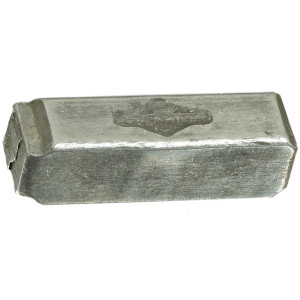
This step-by-step lawn mower repair guide explains how to replace the flywheel key on a lawn mower with a flathead engine. The flywheel key is a rectangular metal peg that keeps the crankshaft and flywheel aligned when you tighten the flywheel nut. If the mower blade hits an object with enough force to knock the flywheel out of alignment, the flywheel key breaks, protecting expensive parts such as the crankshaft from damage.
If the flywheel key shears slightly, the engine runs rough or misfires. If the key breaks, the lawn mower stops running and won't start. When you try to start the engine, the starter rope might jerk back. Replace the flywheel key with the manufacturer-approved lawn mower part.
Use these steps to replace the flywheel key in common Briggs & Stratton flathead engines that power Craftsman, Husqvarna, MTD, Toro, Poulan, Troybilt, Cub Cadet, Murray and Ariens walk-behind lawn mowers.
If your lawn mower is a newer model with an overhead valve (OHV) engine, see How to Replace a Lawn Mower Flywheel Key on an OHV Engine.
Quick links
Instructions
Tools required
Phillips screwdriver
Socket wrench
Socket set
Torque wrench
2-jaw puller
Hammer
Needle-nose pliers
Small slot screwdriver
Repair difficulty
Time required
45 minutes or less
Repair difficulty
Time required
45 minutes or less
Instructions
- 01.
Disconnect the spark plug wire
Disconnect the spark wire so there's no chance that the mower could accidentally start.
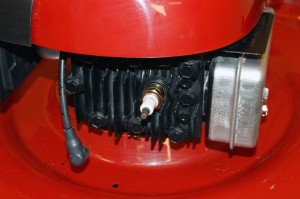
PHOTO: Disconnect the lawn mower spark plug wire.
- 02.
Remove the starter rope from the guide
Remove the starter rope from the rope guide. If the rope won't slip past the guide and the handle, loosen the guide.
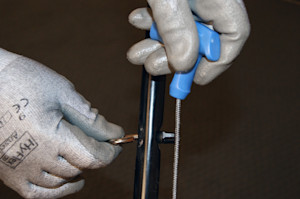
PHOTO: Remove the starter rope.
- 03.
Remove the engine cover
Remove the screws securing the engine cover to the engine. Slide the rope through the hole in the engine cover.

PHOTO: Remove the engine cover.
- 04.
Remove the fuel tank
Remove the screws that secure the fuel tank to the engine. Lift the tank off, being careful to keep the fuel tank upright so it doesn't leak.
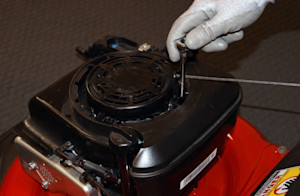
PHOTO: Remove the fuel tank.
- 05.
Remove the dipstick
Remove the screw that secures the dipstick tube to the housing. Remove the dipstick from the engine and plug the hole with a paper towel to keep debris from falling into the engine.
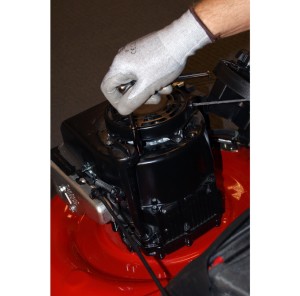
PHOTO: Remove the dipstick tube.
- 06.
Remove engine blower housing
Remove the bolts securing the blower housing to the engine and remove the housing from the engine.
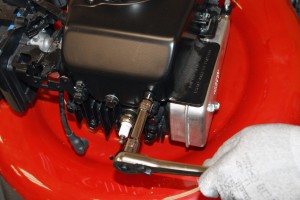
PHOTO: Remove the blower housing.
- 07.
Immobilize the brake pad and crankshaft
Pull the engine control bail against the handle and secure it with a piece of rope to move the engine brake pad away from the flywheel.
Tip the mower onto its side with the air filter up. Wedge a block of wood between the mower blade and the housing to keep the crankshaft from turning when you loosen the flywheel nut.
- 08.
Free the flywheel
Remove the flywheel nut and starter cup. To protect the crankshaft thread, rethread the nut so it's flush with the end of the crankshaft.
Hook the jaws of the 2-jaw puller under each side of the flywheel and tighten the puller bolt. Tap the end of the bolt with a hammer to pop the flywheel loose.
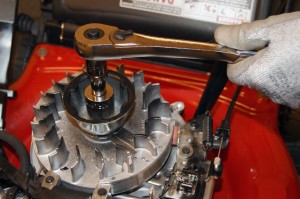
PHOTO: Remove the flywheel nut.
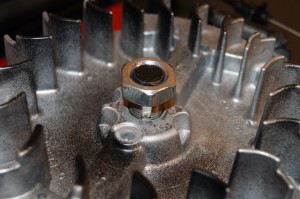
PHOTO: Thread the nut onto the end of the crankshaft.
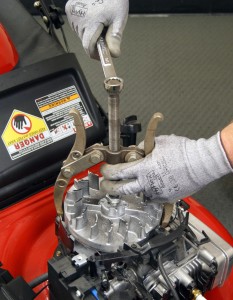
PHOTO: Position the 2-jaw puller on the flywheel.
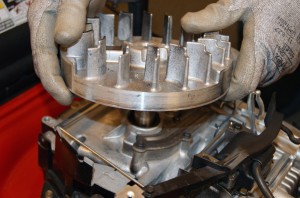
PHOTO: Remove the nut and the flywheel.
- 09.
Remove the flywheel key
Remove the flywheel nut and flywheel. Use needle-nose pliers to remove the flywheel key. If it's sheared in 2 pieces, you might need to use a small screwdriver to remove the pieces.
- 10.
Install the new flywheel key
Install the new key into the slot of the crankshaft. Align the slot in the flywheel with the key and push it on to the crankshaft.
Reinstall the starter cup and flywheel nut. Make sure the block of wood is in position so the engine doesn't rotate while you tighten the flywheel nut.
- 11.
Reassemble the mower
Position the engine blower housing on the engine and bolt it into place.
Remove the paper towel from the dipstick opening, slide the dipstick into the engine and secure it with the screw.
Feed the starter rope handle through the engine cover up to the rope guide.
Reinstall the fuel tank.
Position the engine cover on the engine and screw it into place.
- 12.
Reconnect the spark plug wire
Attach the spark plug wire and make sure the mower works properly.
Warning: Undertaking repairs to appliances can be hazardous. Use the proper tools and safety equipment noted in the guide and follow all instructions. Don’t proceed until you’re confident that you understand all the steps and are capable of completing the repair. Some repairs should only be performed by a qualified technician.
Symptoms for gas walk-behind mowers
Choose a symptom to see related walk-behind mower repairs.
Main causes: drive control cable failure, worn or broken drive belt, bad transmission, broken drive wheel…
Main causes: engine needs tune up, dirty or clogged carburetor, damaged flywheel key…
Main causes: dirty carburetor, bad spark plug, clogged air filter, engine choke problems, clogged gas cap vent…
Main causes: damaged cutting blade, loose cutting blade, damaged flywheel key, engine needs tune up…
Main causes: stale gas, engine needs tune up, bad spark plug, dead battery, bad recoil starter, faulty safety switch, ba…
Main causes: uneven wheel height settings, damaged wheel, dull or damaged cutting blade…
Repair guides for gas walk-behind mowers
These step-by-step repair guides will help you safely fix what’s broken on your walk-behind lawn mower.
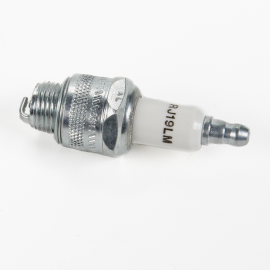
How to replace a lawn mower spark plug
Take a few minutes to replace the spark plug during your lawn mower's annual tune-up or if the spark plug is burnt or cr…
Repair difficulty
Time required
15 minutes or less
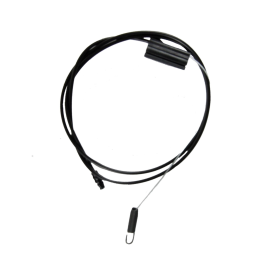
How to replace a lawn mower drive cable
The drive cable engages the transmission to spin the drive wheels and move the mower across the grass. Replace the drive…
Repair difficulty
Time required
60 minutes or less
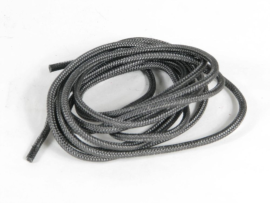
How to replace a lawn mower starter rope
These step-by-step instructions show how to replace a broken starter pull rope on a walk-behind lawn mower.…
Repair difficulty
Time required
30 minutes or less
Effective articles & videos to help repair your walk-behind mowers
Use the advice and tips in these articles and videos to get the most out of your walk-behind lawn mower.

Wondering when to mow your lawn for the best results? Timing matters more than you might think. Discover the best time o…
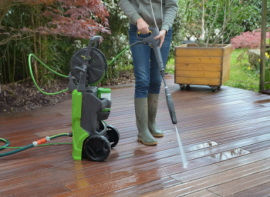
Learn about the top 10 must-have electric lawn & garden tools for 2023…

Learn about all the convenient features on our Sears PartsDirect website that make your parts purchases easier.…